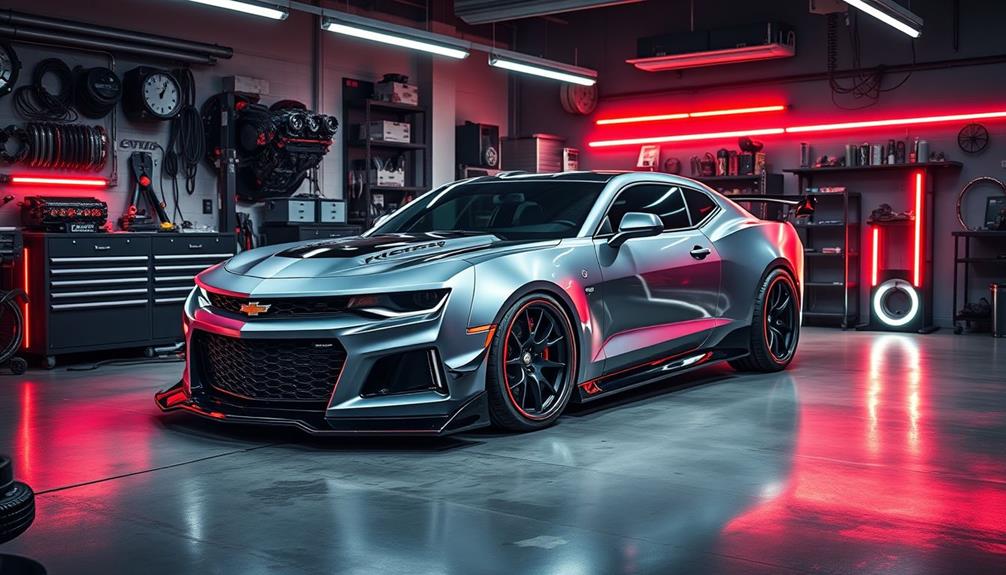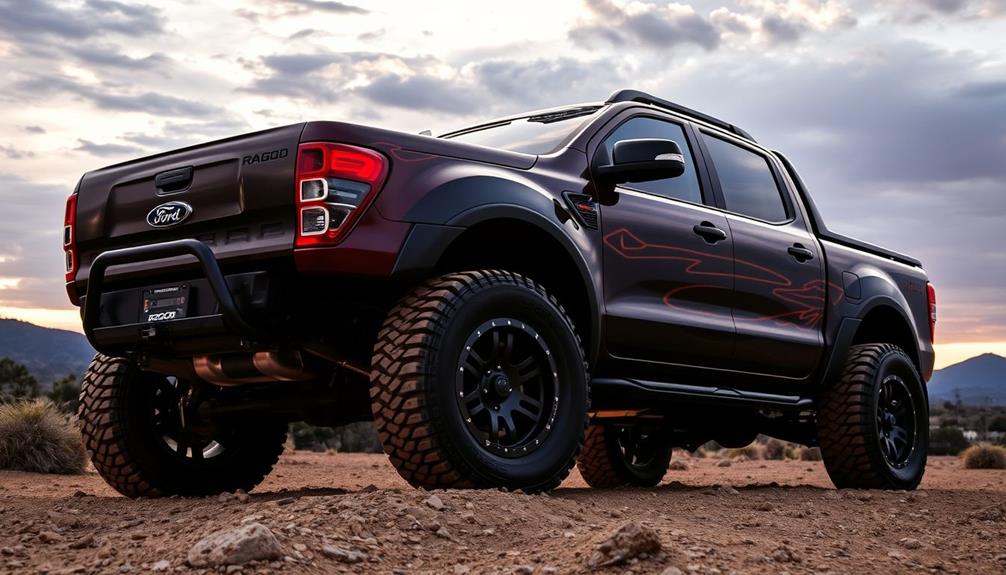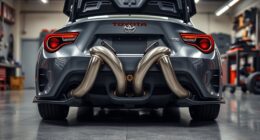Tuning your Ford Focus MK2 can greatly boost its performance, transforming it from 225hp to over 300hp. Start with a Revo Stage 1 remap to enhance power, and consider a Milltek cat-back exhaust for better sound and flow. Upgrading components like the intercooler and injectors can further maximize your gains. For those wanting even more, advanced mods can push boundaries towards 400hp. Plus, engaging with the thriving tuning community can provide helpful tips and insights. There's a lot more to explore in achieving your desired performance from this compact hatchback.
Key Takeaways
- Start with a Revo Stage 1 remap to boost your Ford Focus MK2's power from 225hp to over 260hp.
- Upgrade to a Milltek 3 cat-back exhaust system for enhanced sound and improved performance at around £650.
- Consider installing an Airtec Stage 2 Gen-3 intercooler to maintain optimal engine temperatures during performance driving.
- Engage with the Ford Focus MK2 tuning community for insights and shared experiences on modifications and maintenance.
- Regular dyno testing is crucial to ensure reliability and validate performance gains from your tuning upgrades.
Overview of the Ford Focus MK2
The Ford Focus MK2, introduced in 2005, quickly became a favorite among car enthusiasts, thanks in part to its dynamic design and robust performance. The standout model, the Focus ST Mk2, boasts a powerful 2.5-litre, five-cylinder turbo engine that pumps out an impressive 225hp, firmly positioning it in the hot hatch segment.
Built on a platform shared with the Volvo S40 and Mazda3, this model delivers enhanced handling and improved interior quality, making every drive enjoyable.
In 2008, a facelift introduced the Kinetic Design language, giving the Focus ST a more aggressive and stylish appearance. You can choose between three specification levels—ST, ST-2, and ST-3—each offering various features, with the ST-3 including premium upgrades like leather trim and an advanced stereo system.
When considering performance upgrades, the Focus ST offers a wide range of aftermarket options, allowing you to enhance its already impressive capabilities.
Whether you aim for better acceleration or improved handling, the Focus ST MK2 is a solid foundation for your tuning journey, letting you release the full potential of your compact hatchback.
Common Issues and Solutions

When tuning your Ford Focus MK2, you'll want to be aware of some common issues that can affect performance.
Engine reliability concerns, erratic boost control, and body corrosion are key areas to keep an eye on.
Addressing these problems early can save you from costly repairs down the line.
Engine Reliability Concerns
For owners of the Ford Focus ST Mk2, understanding engine reliability concerns is crucial to maintaining performance and longevity. Some common issues can greatly affect your driving experience if not addressed promptly.
Here's a quick overview of these concerns:
| Issue | Symptoms | Solutions |
|---|---|---|
| Cylinder Liner Failure | Engine misfires, mayonnaise-like residue | Inspect liners and replace if necessary |
| Alternator Problems | Battery warning lights on dashboard | Test alternator and replace if faulty |
| Oil Filter Housing Diaphragm Splits | Whistling noises, oil leaks | Replace oil filter housing |
You should also be aware of body corrosion, particularly where the rear bumper meets the wheel arches. Regular inspections during your purchasing process can save you from costly repairs later. By staying informed about these engine reliability issues in your Focus Mk, you'll not only enhance your car's performance but also make sure it stays on the road for years to come. Preventive maintenance is key, so don't neglect these signs!
Boost Control Problems
Boost control problems can greatly impact your driving experience in the Ford Focus ST Mk2, especially when they stem from issues like faulty boost solenoids. Erratic boost gauge readings and inconsistent power delivery can leave you frustrated.
To address these challenges and enhance your car's performance, keep an eye on the following common issues:
- Faulty Boost Solenoids: Replace them if you notice erratic boost levels.
- Oil Filler "Mayonnaise": This could signal cylinder liner failure, affecting boost performance.
- Oil Filter Housing Diaphragm: Regularly check for splits to prevent whistling noises and inefficient boost control.
- Electrical Connections and Vacuum Lines: Confirm they're intact; any leaks or damage can disrupt boost pressure.
Upgrading to a reliable aftermarket boost controller can also markedly improve your vehicle's performance. It allows for more precise management of boost levels, making your tuning efforts more effective.
Body Corrosion Issues
Body corrosion poses a significant threat to the longevity and aesthetics of your Ford Focus ST Mk2. One of the most common areas where you might encounter this issue is where the rear bumper meets the wheel arches. If you don't address it promptly, it can lead to serious rust problems.
Regularly inspect these areas for paint chips and scratches, as they can allow moisture to accumulate, exacerbating corrosion. To mitigate the risk of rust forming, consider applying protective coatings or sealants in vulnerable spots around the rear bumper and wheel arches. This extra layer can help shield your car from the elements.
Additionally, guarantee proper drainage in the rear wheel arch area by clearing any debris that may block drainage channels. Keeping these areas clean reduces moisture retention, which is key in preventing body corrosion.
If you're buying a used Focus ST Mk2, be sure to check the vehicle's history for any previous repairs related to body corrosion. This can indicate ongoing issues with rust management, helping you make an informed decision.
Taking these steps will help keep your Ford looking great and running strong for years to come.
Essential Tuning Basics

When you start tuning your Ford Focus ST Mk2, focus on initial upgrades like a Milltek exhaust and a Revo remap to boost performance considerably.
Popular tuning goals often aim for around 400hp, but remember to take into account supporting modifications for reliability.
Don't forget to tap into community support resources for tips and advice along the way.
Initial Upgrade Recommendations
Upgrading your Ford Focus MK2 can transform your driving experience, making it more enjoyable and dynamic.
To kickstart your tuning journey, focus on these initial upgrades that markedly enhance performance:
- Milltek 3 Cat-Back Exhaust System – Priced at £650, this upgrade not only improves sound but also boosts performance by enhancing exhaust flow.
- Revo Stage 1 Remap – For £299, this remap elevates your Focus ST's power output to over 260hp, giving you quicker acceleration and a more thrilling drive.
- Airtec Stage 2 Gen-3 Intercooler – Available for £299, this intercooler helps maintain ideal engine temperatures, guaranteeing your vehicle performs at its best during spirited driving.
- Downpipe and De-Cat Packages – Starting at £259, these are essential for reducing back pressure and improving overall exhaust flow, which contributes to better performance.
Consider these initial upgrades to release your Ford Focus MK2's potential.
Also, when purchasing a used Focus ST, check the condition of the Recaro seats and the overall body integrity to guarantee long-term enjoyment and reliability.
Popular Tuning Goals
Many Ford Focus MK2 enthusiasts set ambitious tuning goals to elevate their driving experience. These goals often revolve around increasing horsepower and optimizing performance. If you're aiming for a boost in power, consider starting with a Revo Stage 1 remap, which can raise your output to over 260hp. Pair this with a Milltek 3 cat-back system for enhanced exhaust flow, priced at £650.
As you progress to Stage 2 tuning, you'll need to upgrade the exhaust, induction, and intercooler systems. Popular options include the Airtec Stage 2 Gen-3 intercooler for £299 and downpipe/de-cat packages starting at £259 to improve airflow and reduce turbo lag. Many enthusiasts dream of hitting around 400hp, which can be achieved through advanced modifications, including hybrid turbo upgrades.
Here's a quick overview of popular tuning upgrades:
| Upgrade Type | Cost |
|---|---|
| Revo Stage 1 Remap | £299 |
| Milltek Cat-Back System | £650 |
| Airtec Stage 2 Intercooler | £299 |
With these upgrades, you'll reveal your Ford Focus MK2's true potential on the road.
Community Support Resources
Tapping into the thriving Ford Focus MK2 tuning community can be a game changer for your modification journey.
With numerous resources at your fingertips, you'll find a wealth of community support that can guide you through performance enhancements effectively.
Here are some essential resources to take into account:
- Tuning Forums: Engaging in forums allows you to connect with fellow enthusiasts who share their experiences, tips, and tricks.
- ECU Remapping Services: Services like Revo Stage 1 can greatly boost your horsepower, often increasing it from 225hp to over 260hp for around £299.
- Tuning Boxes: Options such as the Spider tuning box provide multiple settings and can enhance your power by up to 30hp without affecting your warranty.
- Dyno Testing: Community members emphasize the importance of dyno testing to validate your modifications, ensuring your performance claims are backed by reliable data.
Advanced Upgrades and Modifications

To truly release the potential of your Ford Focus MK2, consider investing in advanced upgrades and modifications that elevate both performance and handling. By implementing these changes, you'll notice a significant improvement in driving experience and overall vehicle capability.
| Upgrade/Modification | Approximate Cost |
|---|---|
| Revo Stage 2 Map | – |
| Milltek 3 Cat-Back Exhaust | £650 |
| KW V3 Suspension Setup | £1,470 |
| K-Sport Eight-Pot Brakes | £1,200 |
| Focus RS Clutch Upgrade | £950 |
Start with an upgraded exhaust, like the Milltek 3 cat-back system, to enhance exhaust flow and sound. Pair this with a Revo Stage 2 map to push your power beyond 300hp, but don't forget essential performance enhancements, including an upgraded induction system and intercooler.
To manage that extra power, consider the Focus RS clutch for reliability and performance. Additionally, the KW V3 suspension will transform your handling, making spirited driving a joy. Finally, the K-Sport brake kit guarantees you'll have the stopping power you need for high-performance scenarios.
Performance Goals and Expectations

Setting clear performance goals is essential when tuning your Ford Focus MK2. Knowing what you want from your tuning project helps you make informed decisions and track your progress.
Whether you're looking for a modest boost or aiming for high horsepower, setting realistic expectations will guide your modifications. Here are some performance goals you might consider:
- Increase Horsepower: Start with a Revo Stage 1 remap to jump from 225hp to over 260hp.
- Upgrade Exhaust: Consider a Milltek 3 cat-back exhaust system to enhance sound and performance, priced at around £650.
- Advanced Tuning: For more significant gains, look into a Revo Stage 2 map, which can push your Focus beyond 300hp with supporting mods.
- Long-Term Reliability: Regular dyno testing will help you verify performance improvements and guarantee your tuning box and other modifications are reliable.
Turbo and Injector Enhancements

When enhancing the turbo and injectors in your Ford Focus MK2, you're stepping into a domain of significant performance upgrades that can transform your driving experience.
Upgrading to 110 injectors can greatly boost your diesel power potential, leading to improved fuel efficiency and performance gains.
Consider installing a larger turbo, like the GT1544V Hybrid Turbo, for substantial power increases. Combining this with fixed-vane turbos and electronic boost controllers helps reduce lag, guaranteeing better acceleration.
However, remember that the stock turbo has limitations; pushing it too hard can jeopardize engine reliability.
To maximize the benefits of your new turbo and injectors, a custom remap is essential. This optimization guarantees that your upgraded injectors and intercoolers work together effectively, revealing significant power gains.
Additionally, implementing EGR deletes and larger intercoolers alongside your turbo upgrades can enhance performance without sacrificing reliability.
User Experiences and Insights

Many Ford Focus MK2 owners have shared their experiences with tuning, revealing a spectrum of insights that can guide your own upgrades. One common theme is the impressive performance gains users report after installing tuning boxes, with power increases of up to 30hp and 70nm.
Owners particularly praise the Spider tuning box for its ease of installation and dynamic settings, making it suitable for various driving conditions.
However, opinions vary on tuning methods. Here are some key insights you might find helpful:
- Performance Gains: Users note that while tuning boxes provide significant boosts, full remaps often yield even better results.
- Convenience: Many prefer tuning boxes for their straightforward installation and flexibility, which reduces concerns about warranty issues.
- Dyno Testing: Enthusiasts emphasize the importance of dyno testing to validate performance claims and guarantee modifications meet your goals.
- Personal Preference: Some drivers lean towards remaps for reliability, while others enjoy the adaptability offered by tuning boxes.
Cost and Value Considerations

Tuning your Ford Focus MK2 can yield impressive performance gains, but understanding the costs involved is just as important. The initial investment can be quite varied; for instance, tuning boxes start at around £80, making them a budget-friendly option compared to remapping, which can exceed £250.
If you're looking for a thorough tuning package, companies like Demon Performance or RaceChip offer options around £2,341.99 that promise significant horsepower increases.
Upgrading specific components can also enhance performance. A Milltek exhaust system costs about £650, while a Revo Stage 1 remap is around £299. These enhancements together can lead to substantial performance boosts.
For those wanting advanced tuning, investing in high-quality upgrades like the KW V3 suspension at £1,470 and K-Sport brakes at £1,200 can elevate both handling and safety, making the overall cost worthwhile.
Keep in mind that modifications may raise your insurance premiums, so it's crucial to factor in these potential increases when budgeting for your performance upgrades.
Frequently Asked Questions
Are Ford Focus Hatchbacks Fast?
Yes, Ford Focus hatchbacks can be fast. With a powerful engine and lightweight design, they accelerate quickly and handle well, making them competitive in their class. You'll enjoy a thrilling driving experience behind the wheel.
What Is the Ford Focus Block Mod?
Think of the Ford Focus block mod as a superhero's armor. It reinforces your engine block, allowing it to handle more power without breaking down. Upgrading cylinder liners and coolant flow boosts durability for high-performance driving.
Can You Tune a Ford Focus?
Yes, you can definitely tune a Ford Focus. Start with simple upgrades like exhaust systems and remapping. As you gain experience, consider extensive mods for even more power and performance enhancements tailored to your preferences.
Is the Mk2 Focus Rs Reliable?
Isn't it reassuring knowing the Mk2 Focus RS generally holds up well? With proper maintenance, you'll find it reliable, though keep an eye on the turbo and clutch if you drive it hard. Regular care's key!
Conclusion
In summary, tuning your Ford Focus MK2 can truly transform your ride from a humble hatchback into a thrilling machine that’ll leave competitors in the dust. By understanding common issues and exploring essential upgrades, you access its full potential. Remember, it’s not just about performance; it’s about enjoying the journey—like cruising in a vintage convertible down Route 66. Immerse yourself in this adventure, and you’ll find that the road ahead is filled with excitement and possibilities! When it comes to Ford Focus MK1 tuning, the same principles apply. By addressing common issues and implementing key upgrades, you can elevate the performance of your MK1 to new heights. Embrace the thrill of the journey and the endless possibilities that come with fine-tuning your Ford Focus, whether it’s a MK1 or MK2. Remember, it’s all about experiencing the joy of driving and unleashing the full potential of your beloved vehicle.










